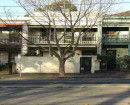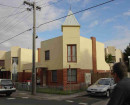CASTERTON CHURCH AND RESIDENTIAL PRECINCT (WEST HILL)
HENTY STREET, CASTERTON, GLENELG SHIRE
-
Add to tour
You must log in to do that.
-
Share
-
Shortlist place
You must log in to do that.
- Download report


Statement of Significance
What is significant?
The Casterton Church and Residential Precinct (West Hill) is located along the Glenelg Highway, west of the central shopping area, overlooking the township. Generally, the built fabric shows a good range of houses and cottages dating from the 1856 (when the first land sales took place in this area) through to the mid twentieth century, as well as three fine churches and one former church, built in 1865, now used as the Masonic Lodge. A memorial to the Boer War, World War One and World War Two is located in a triangular reserve in the Henty Street road reserve at the extreme west of the precinct. The street is lined with Corymbia ficifolia (Red Flowering Gum), planted as street trees along most of Henty Street in the early twentieth century. Overall, the precinct is in very good condition and retains a very high degree of integrity.
How is it significant?
The Casterton Church and Residential Precinct (West Hill) is of historic, cultural, social and architectural significance to the Glenelg Shire.
Why is it significant?
The Casterton Church and Residential Precinct (West Hill) is of historic significance as it shows the growth and development in its built form of the town of Casterton from the mid 1850s through to the mid twentieth century. It is a representative example of the pattern of development of residential buildings around religious buildings often occurred in small country towns in the nineteenth and early twentieth century. Of further historical significance is the town's role as a major service and religious focus for the surrounding area, being the second largest township in the Shire. It is of cultural significance for its range of churches and their residences, including the former Presbyterian Church (now Masonic Lodge), dating from 1865, the Methodist Church and manse, dating from 1877, Christ Church Anglican, dating from 1866 and the current Scot's Uniting Church, dating from 1908. Of further interest is the absence of the Catholic Church from this precinct. It is of social significance as the focus for the community's religious and spiritual needs, and better housing in the township, away from the 'miasmas' which were feared in the nineteenth century, and as a continuity of the 'better' part of town. The architectural significance of the precinct lies in a range of buildings constructed from local materials over a long period of time, ranging from the fine brick and stone religious buildings through to the humble timber cottages which remain.
-
-
CASTERTON CHURCH AND RESIDENTIAL PRECINCT (WEST HILL) - Physical Description 1
The Casterton Church and Residential Precinct (West Hill) is located along the Glenelg Highway (Henty Street) to the south west of the Commercial shopping strip. Geographically, this area is set on a hill, which overlooks the flats and commercial area of the township. The precinct consists predominately of single storey timber residential buildings, dating from the 1860s through to the 1980s, and three of the four major churches in Casterton. These are the former Methodist Church and Parsonage (at 177 and 179 Henty Street), the Scot's Uniting (former Presbyterian) Church at 174 Henty Street and the Christ Church Anglican Church and former Rectory at 184 and 188 Henty Street. The Masonic Lodge, which was built as the first Presbyterian Church is also located in the precinct, at 154 Henty Street. The street is lined with Corymbia ficifolia (Red Flowering Gum), planted as street trees along most of Henty Street in the early twentieth century. The trees in the commercial area have been removed and replaced with ornamental pears, after many decades of pollarding saw their decline. Those which remain in the precinct vary in condition from fair to very good. The residences are mainly timber, although there is a concrete block house at 196 Henty Street, and the religious buildings, such as the former Methodist Manse and the former Anglican Rectory are constructed of local brick. The late nineteenth and early twentieth century buildings give the area a sense of affluence in comparison to some of the dwellings on the river flat areas and in other areas of the township. The integrity of most of the buildings within the precinct is very high, as is the condition. The only two storey building in the precinct is a former surgery and residence, which has been much altered, and has a lesser degree of significance than the other buildings. Overall, the precinct is in very good condition and retains a very high degree of integrity. A small reserve which contains three memorials to the Boer War, First Wold War and Second World War is located at the extreme west of the precinct.
Contributory places
. Lyndhurst, 165 Henty Street Casterton. Timber Cottage "Bonnay", 167 Henty Street Casterton
. House, 169 Henty Street Casterton
. Timber Cottage, 170 Henty Street Casterton
. House, 171 Henty Street Casterton
. Timber Cottage, 173 Henty Street Casterton
. Timber Cottage, 175 Henty Street Casterton
. Timber House, 178 Henty Street Casterton
. Timber House, 180 Henty Street Casterton
. Timber House, 182 Henty Street Casterton
. Timber House, 185 Henty Street Casterton
. Timber Cottage, 192 Henty Street Casterton
. Timber Cottage, 194 Henty Street Casterton
. Timber House, 195 Henty Street Casterton
. Concrete Block House, 196 Henty Street, Casterton
. Timber House, 197 Henty Street Casterton
. Timber House, 200 Henty Street Casterton
. Timber House, 201 Henty Street Casterton
. Carmichael Residence, 203 Henty Street Casterton
. Timber House, 205 Henty Street Casterton
. Timber House, 207 Henty Street Casterton
. Timber House, 209 Henty Street Casterton
. Timber House, 211 Henty Street Casterton
. Timber House, 213 Henty Street Casterton
. Mt Gambier Stone, 215 Henty Street Casterton
. House & outbuildings, 224 Henty Street, Casterton
. Edwardian House, 229 Henty Street Casterton
. Timber House, 231 Henty Street Casterton
. Timber Federation House, 235 Henty Street Casterton
. Timber Cottage, 237 Henty Street Casterton
. Timber house, 92 Jackson Street, Casterton
. House, 7 Miller Street, Casterton
. Timber House, 11 Miller Street, Casterton
. Timber House, 13 Miller Street, Casterton
Significant places
. Street Trees - Corymbia ficifolia (red flowering gums), Henty Street, Casterton
. CWA Rooms, 164 Henty Street Casterton
. Scot's Uniting Church, 176 Henty Street Casterton
. Former Methodist Church, 177 Henty Street Casterton
. Former Methodist Parsonage 179 Henty Street Casterton
. Christ Church Anglican, 184 Henty Street Casterton
. Former Rectory, 186 Henty Street, Casterton
. Kadisha, 210 Henty Street Casterton
Cast Iron Boer War Memorial, World Wars One and Two Memorial and reserve, Glenelg Highway, Casterton
CASTERTON CHURCH AND RESIDENTIAL PRECINCT (WEST HILL) - Historical Australian Themes
4.1: Planning urban settlements
4.1.1: Selecting township sites
4.5: Making settlements to serve rural Australia
4.6: Remembering significant phases in the development of settlements, towns and cities
6.1: Forming associations, libraries and institutes for self-education
8.6: Worshipping
8.6.1: Worshipping together
8.6.2: Maintaining religious traditions and ceremonies
8.6.4: Making places for worshipHeritage Study and Grading
Glenelg - Glenelg Shire Heritage Study Part One
Author: Carlotta Kellaway, David Rhodes Mandy Jean
Year: 2002
Grading:Glenelg - Glenelg Heritage Study Stage Two (a)
Author: Heritage Matters
Year: 2006
Grading:
-
-
-
-
-
CASTERTON RAILWAY STATION
 Victorian Heritage Register H1663
Victorian Heritage Register H1663 -
TOWN HALL
 Southern Grampians Shire
Southern Grampians Shire -
STOCK SELLING RING
 Glenelg Shire
Glenelg Shire
-
3 Sherwood Street
 Yarra City
Yarra City -
Archaeological site
 Southern Grampians Shire
Southern Grampians Shire -
BLACKWOOD HOMESTEAD COMPLEX AND CEMETERY
 Southern Grampians Shire
Southern Grampians Shire
-
-











